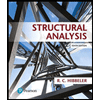
Structural Analysis
6th Edition
ISBN: 9781337630931
Author: KASSIMALI, Aslam.
Publisher: Cengage,
expand_more
expand_more
format_list_bulleted
Question

Transcribed Image Text:PROBLEM: Find the average rainfall by using Isohyetal method for a square
catchment area, bounded at the corners by four gage stations. Plot the isohyets
as straight lines and assume an isohyet interval of 1 cm. The coordinates of the
station and rainfall values are given below. Show the diagram and the tabulated
solution in your paper.
(Final answer until 3-decimal places only. Indicate the unit)
Station
1
2
3
4
(50, 80) (100, 80) (50, 20)
(100, 20)
Coordinates, km
Rainfall, cm
1
3
3
Your answer
This is a required question
Expert Solution
This question has been solved!
Explore an expertly crafted, step-by-step solution for a thorough understanding of key concepts.
This is a popular solution
Trending nowThis is a popular solution!
Step by stepSolved in 3 steps with 1 images

Knowledge Booster
Similar questions
- The 60-year record shows that the annual maximum discharges for a river have a mean of 30,000 cfs, a standard deviation of 28,000 cfs, and a skewness coefficient of 3.15. If the annual maximum discharge can be described by the Extreme-value Type I distribution, what is the probability that the annual maximum discharge exceeds 100,000 cfs at least once in next 10 years? (Note: The sample size is 60. Conduct interpolation using exceedance probabilities or cumulative probabilities.)arrow_forwardStation Rainfall (mm) Annual (mm) ДХ (m) ΔΥ (m) Area (m²) A 42 500 10 25 1500 30 480 15 30 2000 50 558 24 30 830 526 500 E 35 590 40 19 1200 Using a rainfall of 386 mm for rain gauge Station D, determine the average depth of rainfall that fell for the watershed using the arithmetic average, and Thiessen polygon method. The areas for the Thiessen polygon method are given in the table above for each station. B.arrow_forwardUsing a rainfall of 386 mm for rain gauge Station D, determine the average depth of rainfall that fell for the watershed using the arithmetic average, and Thiessen polygon method. The areas for the Thiessen polygon method are given in the table above for each station. Determine the average depth of rainfall for a watershed using the isohyetal method given the data below. Isohyet (mm) Area Associated (km²) 30 - 40 20 20 - 30 45 10 - 20 35 under 10arrow_forward
arrow_back_ios
arrow_forward_ios
Recommended textbooks for you

 Structural Analysis (10th Edition)Civil EngineeringISBN:9780134610672Author:Russell C. HibbelerPublisher:PEARSON
Structural Analysis (10th Edition)Civil EngineeringISBN:9780134610672Author:Russell C. HibbelerPublisher:PEARSON Principles of Foundation Engineering (MindTap Cou...Civil EngineeringISBN:9781337705028Author:Braja M. Das, Nagaratnam SivakuganPublisher:Cengage Learning
Principles of Foundation Engineering (MindTap Cou...Civil EngineeringISBN:9781337705028Author:Braja M. Das, Nagaratnam SivakuganPublisher:Cengage Learning Fundamentals of Structural AnalysisCivil EngineeringISBN:9780073398006Author:Kenneth M. Leet Emeritus, Chia-Ming Uang, Joel LanningPublisher:McGraw-Hill Education
Fundamentals of Structural AnalysisCivil EngineeringISBN:9780073398006Author:Kenneth M. Leet Emeritus, Chia-Ming Uang, Joel LanningPublisher:McGraw-Hill Education
 Traffic and Highway EngineeringCivil EngineeringISBN:9781305156241Author:Garber, Nicholas J.Publisher:Cengage Learning
Traffic and Highway EngineeringCivil EngineeringISBN:9781305156241Author:Garber, Nicholas J.Publisher:Cengage Learning


Structural Analysis (10th Edition)
Civil Engineering
ISBN:9780134610672
Author:Russell C. Hibbeler
Publisher:PEARSON

Principles of Foundation Engineering (MindTap Cou...
Civil Engineering
ISBN:9781337705028
Author:Braja M. Das, Nagaratnam Sivakugan
Publisher:Cengage Learning

Fundamentals of Structural Analysis
Civil Engineering
ISBN:9780073398006
Author:Kenneth M. Leet Emeritus, Chia-Ming Uang, Joel Lanning
Publisher:McGraw-Hill Education


Traffic and Highway Engineering
Civil Engineering
ISBN:9781305156241
Author:Garber, Nicholas J.
Publisher:Cengage Learning